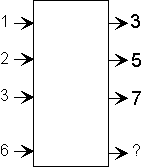Year 2 Free Week #5 Lesson Plan - Review
of Number Sense
- (5 min) PRIME NUMBERS AND PRIME FACTORS
A prime number is any number, greater than one, that is not
divisible by any number except itself and 1. Is 1 a prime number? NO, by
definition. (although 1 is a perfect square.) Name the prime numbers
between 50 and 60: [53 and 59] Note that neither 51 nor 57 is prime
because they are both divisible by 3. We know that because the sum of
their digits (6 and 12) are divisible by 3.
We are frequently asked to find the prime factors of a number. We do this
by breaking it down, in an upside down tree, until all the numbers are
prime. If a number has the same prime factor more than once, list them
all. For instance, the prime factors of 12 are 3, 2, and 2 - or - 3 and
22.
If you asked to find the greatest common factor, GCF, of two numbers, it
will be smaller because a factor is smaller. If you are asked to
find the least common multiple (LCM), it will b larger because you
must multiply.
- SEQUENCES
If you are asked to find the next number in a sequence, find out what you
do to the first to get the second, and what you do to the second to get
the third. Sometimes there will be two things going on.
What is next: 1...2...4...? Well it could be either +1, +2, +3 or it
could be
x2, x2, x2. You need to look at the next number to know for sure. If the
next number is 7, then you are adding. If the next number is 8, then you
are multiplying by 2 each time.
- NUMBER MACHINES
Mathematicians like to play with number machines. A number machine is a
machine which operates on a number to give a new number. An equation is a
number machine. You may be given a problem with a diagram, like the one
below, where you are putting in different numbers and getting out
different numbers.

In this problem you are asked to find out what comes
out when you put in a 6. To figure this out you must find out the rule of
what happens inside the machine. This machine takes a number, x,
multiplies by 2 and adds 1. So a 13 comes out when we put in a six.
This kind of problem can take on other forms, as well. Sometimes the
number machine is drawn as a special character (@ or &). If this happens,
just plug in the number you are given in the right places.
So if a@b=4a+2b, then 3@4 = 4 x 3 + 2 x 4 = 20
Also the number machine is sometimes represented as a function:
f(x) = 4x + 2. Then f(5) would be 4 x 5 + 2 or 22.
The most complicated thing you may see, would be two number machines
together. They would look like this:
If a@b=4a+2b, then what is (3@4)@5.
In this case, do it one step at a time, doing what's inside the
parentheses first.
3@4 is 20. Now figure out 20@5 = 90
Number machines are a lot like sequences. Just don't let them freak you
out!
- In-class exercise
- No homework this week!
|